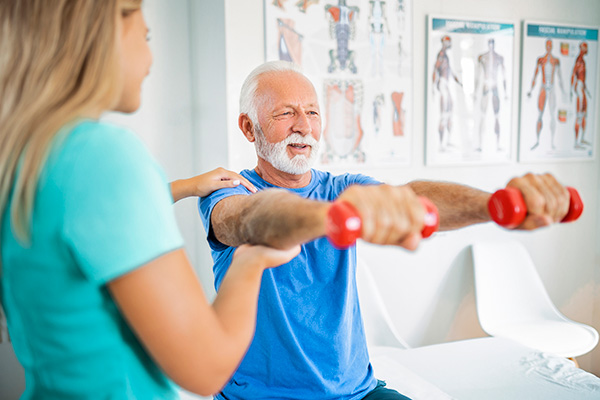Bone Up with PT

Did you know that physical therapy (PT) can help protect your bones before and after a diagnosis? It’s true! May is National Osteoporosis Month and a good time to learn the ways PT supports osteoporosis prevention and recovery.
What is osteoporosis?
Osteoporosis is a “silent” disease that many people do not know they have until something major happens, like a broken hip, wrist, or spine. Bones are living tissues which are constantly changing, with bone being destroyed and replaced; osteoporosis occurs when there isn’t enough new bone created to replace the old bone. Bones become so brittle that slight stresses (like a heavy cough) can cause fractures.
Osteoporosis can affect anyone, but those at most risk tend to be menopausal women, especially those who are white or of Asian descent. Older age, smaller body frames, family history, and some medical conditions and medications can also raise the risk of developing osteoporosis. A test which uses low levels of x-rays can measure bone density and evaluate points that might likely fracture.
How can PT help with osteoporosis?
Research has shown that one of the best preventions and treatments for osteoporosis is physical activity. Physical therapists are movement experts trained to use many approaches to help individuals live full lives through prescribed exercise, hands-on care, and patient education. That means they are the ideal partners in preventing osteoporosis or helping people recover from related injuries.
Here are some treatment options that a physical therapist might recommend:
- Weight training uses barbells or dumbbells as well as weight machines to increase strength, muscle size and endurance, and help with bone density. Proper form is essential to ensuring benefits without injury.
- Band exercises employ oppositional force to train muscles; the more a band is pulled, the “heavier” it becomes. Like weight training, bands can build strength. Because they are small and easy to transport, band exercises can happen anywhere and can work just about every part of the body.
- Body-weight resistance exercises like pushups, squats, and yoga can be an effective way to build muscle without adding an “external load” like barbells or bands. These types of exercises have been shown to increase muscles endurance, especially in the core, and even increase aerobic capacity.
- Weight-bearing aerobic activities include walking, dancing, gardening, or stair climbing. These exercises involve doing aerobic exercise on your feet, with your bones supporting your weight.
- Posture and balance exercises are important for preventing injury. Posture-focused exercises work on correcting “sloping” shoulders and decrease the risk of breaking bones in the spine. Balance exercises strengthen your legs and can decrease the chance of falling.
Every body is unique even when something can affect any body, like osteoporosis. Physical therapy can play an important role to ensure that your bones are strong enough to support the quality of life you want.
![CPT Rehab [logo]](https://www.cptrehab.com/wp-content/themes/cpt-rehab/images/logo.png)